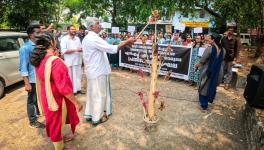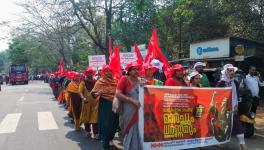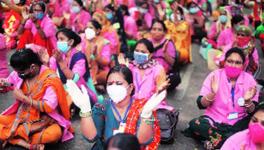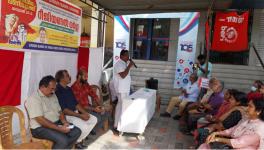How NHM Budget Cuts Directly Hit ASHAs, Impact Public Healthcare
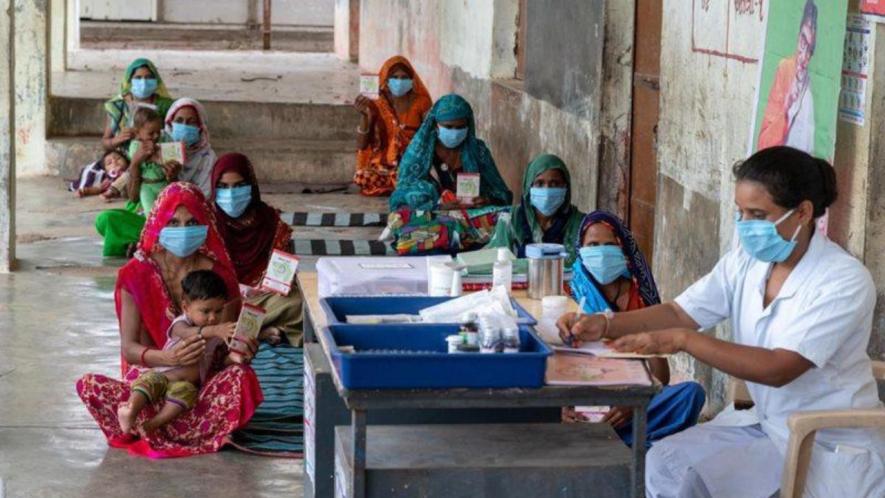
Representational Image.
Lakhs of Accredited Social Health Activists (ASHA) workers serve as the backbone of India's rural healthcare system, acting as a vital link between communities and healthcare institutions. Despite their invaluable contributions, budget cuts in the National Health Mission (NHM) have raised concerns about the financial stability of ASHA workers and, consequently, the effectiveness of India's healthcare delivery system. This article undertakes a comprehensive financial analysis, comparing ASHA worker salaries and NHM budgets in Haryana, Delhi, Maharashtra, and Bihar, shedding light on the far-reaching impact of budget cuts and proposing a multi-pronged approach to sustain their financial well-being.
The National Health Mission, a transformative initiative launched in 2005, has significantly improved India's healthcare landscape. However, budgetary constraints have resulted in a 4% decline in real terms during the 2023-2024 financial year, amounting to a reduction of nearly ₹3,740 crore compared with the previous year, as the share of the NHM in the total allocation for the health budget has decreased from 41.6% in 2022-23 to 39.7% in 2023-2024.
This decrease directly affects the various programmes ASHA workers depend on for their livelihood and service delivery. However, this is a problem that needs to be addressed at the Central level, because state governments have a meagre role to play in it.
ASHA Salaries and NHM Budgets: Comparative Overview
This study reveals a significant disparity in fixed monthly allowances across states. Maharashtra offers the highest compensation at ₹4,000/month, followed by Delhi at ₹3,500, Haryana at ₹3,000, and Bihar at ₹2,000. While performance-based incentives exist in all states, concerns regarding their timely disbursement and adequacy persist. This lack of consistency in base salary and incentive structures raises questions about equity and potential inconsistencies in service delivery across different regions.
This analysis also delves into NHM budgets for each state. Maharashtra boasts the highest allocation at ₹14,469 crore, followed by Bihar at ₹6,202 crore, Delhi at ₹5,875 crore, and Haryana at ₹3,426 crore. While Bihar witnessed a significant budget increase of ₹1,000 crore, careful monitoring is crucial to ensure this translates into equitable distribution and improved compensation for ASHA workers. In contrast, Haryana's budget cut of ₹85 crore (approximately 2.5%) raises concerns about potential job insecurity and reduced service coverage.
This comparative analysis highlights the need for further investigation into several key areas. First, a deeper exploration of the specific performance-based incentive schemes and their effectiveness in different states is warranted. Second, examining the utilisation rates of NHM budgets allocated for ASHA worker compensation would provide valuable insights into potential gaps between allocation and actual disbursement.
A Look at Haryana's ASHA Worker Strike
Between August 8 and August 19, 2023, a substantial number of ASHA workers in Haryana, over 20,000, engaged in a strike to demand enhanced wages, an extension of the retirement age, and their inclusion in the government's healthcare cadre with a minimum monthly wage of Rs 26,000-- the minimum wages fixed by the Seventh Pay Commission.
It is noteworthy that ASHA workers in Haryana commenced receiving a fixed salary of Rs 4,000 only in 2018 after a prolonged six-month protest. However, over the subsequent five years, their workload increased significantly, while their remuneration remained stagnant.
On August 19, 2023, following an extensive 24-hour sit-in protest across all 22 districts of Haryana, the government, led by Manohar Lal Khattar, acceded to some of their demands. It announced a hike in the fixed monthly honorarium for ASHA workers from Rs. 4,000 to Rs. 6,100 and pledged a retirement benefit of Rs. 2 lakh. Nevertheless, several of their other demands remain unfulfilled.
The scope of responsibilities shouldered by ASHA workers is extensive, acting as a vital link between India's rural communities and the public health delivery system. Their role strengthens the public healthcare system, ensuring widespread access to healthcare services. Despite the substantial and commendable nature of their work, ASHA workers are categorised as ‘volunteers’ receiving an honorarium rather than being recognised as permanent employees.
While the decision by the Haryana government to hike the fixed honorarium from Rs. 4,000 to Rs. 6,100 and promise a retirement benefit of Rs. 2 lakh is a notable initiative, it represents only a modest advancement. The state government contends that its authority is limited in this matter, asserting that since ASHA workers fall under the NHM, a Central government scheme, decisions regarding their recognition as permanent workers or the provision of social security benefits such as ESI (Employees’ State Insurance) Provident Fund, etc., rest with the Central government.
ASHA workers were initially recruited as volunteer workers in 2005 under NHM, and given the socio-economic changes that have transpired between 2005 and 2023, their status warrants reconsideration.
On average, an ASHA worker in Haryana receives a monthly income of about Rs. 9,600, inclusive of the fixed honorarium and task-based incentives. However, they are compelled to cover expenses such as data recharge, transportation of pregnant women to health facilities, procurement and photocopying of survey notebooks, and payment of their own house rents, amounting to Rs. 3,000 and more. This leaves the workers with a residual income of slightly less than Rs. 6,600.
In light of these circumstances, it is imperative for state governments to deliberate on the expectation that ASHA workers operate below the minimum wage threshold. This pressing issue necessitates collaborative discussions with the Central government to address the evolving socio-economic landscape and ensure fair remuneration for the invaluable services rendered by ASHA workers.
Direct Financial Impact on ASHA Workers
Across India's sprawling rural landscape, ASHA workers are the bridge between healthcare and communities. They are the first responders, the educators, the motivators, and the silent guardians of public health, particularly for women and children. However, cuts in the NHM budget are casting a long shadow over these crucial figures, jeopardising their well-being and, ultimately, the health of millions. The 4% decline in allocation in real terms for NHM in 2023-24 directly translates to reduced funding for programmes ASHA workers depend on.
The biggest blow comes in the form of diminished performance-based incentives, a significant portion of their income. Incentives like ₹80 per antenatal checkup in Assam now stand at a meagre ₹50, directly impacting their livelihood. This, coupled with delayed or irregular payments, throws ASHA workers into a vortex of financial insecurity. The dream of a decent living wage remains distant, forcing them to juggle multiple jobs to support their families, compromising the time and energy they can dedicate to their crucial healthcare roles.
Job Insecurity: With limited budgets, states may be forced to reduce the number of ASHA workers employed. This spectre of job insecurity creates immense anxiety, adding to the financial burden. Imagine a village losing its ASHA worker – the vital link to vaccinations, family planning, and basic healthcare knowledge suddenly vanishes, leaving vulnerable communities exposed and helpless.
Infrastructure Bottlenecks: NHM budget cuts translate into delayed infrastructure development in rural areas. This leaves ASHA workers struggling to access and provide essential services. Lack of medical supplies, transportation facilities, and even communication tools, such as smartphones, hamper their ability to reach the most remote areas and effectively deliver healthcare. The ripple effect is clear – compromised infrastructure directly impacts service delivery, jeopardizing the health outcomes of countless rural citizens.
While salary increases are crucial, supporting ASHA workers requires a multifaceted approach. Ensuring timely and regular payments, including salaries and incentives, through robust digital systems is essential to address financial stress and improve worker morale. Enhanced social security benefits, such as health insurance, accident insurance, and pension schemes, are equally important for long-term financial security and attracting qualified individuals to the programme.
Furthermore, investing in capacity building and skill development through training programmes empowers ASHA workers with valuable knowledge and expertise, increasing their worth within the healthcare system and potentially opening doors to career progression and higher salaries.
By implementing these comprehensive strategies, we can create a more supportive and sustainable environment for ASHA workers, ultimately strengthening the healthcare system they play a vital role in.
Financial Feasibility and Alternative Funding Mechanisms
To support and empower ASHA workers effectively, a multifaceted approach that leverages both public and private resources is crucial. Targeted public-private partnerships (PPPs) with private healthcare providers and NGOs can unlock a wealth of benefits for ASHA workers, including supplementary income schemes, and infrastructure improvements.
Additionally, encouraging Corporate Social Responsibility (CSR) initiatives focused on rural healthcare can channel much-needed funding toward ASHA worker compensation and programme development. Strategic partnerships and tax incentives can further bolster this approach, creating a sustainable funding stream for ASHA worker support.
Finally, implementing community-based financing schemes, where local contributions are collected and managed, fosters a sense of ownership and incentivises community participation in maintaining the NHM programmes that ASHA workers are instrumental in delivering. By adopting a comprehensive strategy that combines these diverse elements, we can ensure that ASHA workers have the resources and support they need to serve their communities effectively and contribute to the success of the NHM.
Conclusion
The NHM budget cuts jeopardise the financial well-being of ASHA workers, impacting their ability to deliver essential healthcare services. The plight of female frontline workers like ASHAs highlights a concerning trend: persistent undervaluing of women's work, especially among the most marginalised. These women are trapped in the informal sector with inadequate pay, limited upskilling opportunities, and ever-expanding workloads. This situation mirrors a broader decline in female workforce participation in India, suggesting a lack of decent job opportunities for women.
To address this injustice, ASHAs urgently need reclassification as formal employees. They deserve regular, fair wages exceeding the minimum wage, reflecting the demanding nature of their work. Additionally, long-term social protection measures are essential. Furthermore, empowering them with specialisation options and career advancement pathways within the public health system would not only benefit their well-being but also strengthen the system itself.
While including ASHA workers under Ayushman Bharat-PMJAY in the interim budget 2024-2025 is a positive step, it doesn't fully address their ongoing concerns about financial hardship given the fact that the estimated budgetary allocation towards Ayushman Bharat-PMJAY has seen only a marginal increase, from Rs 7,200 crore in 2023-24 to Rs 7,500 crore this year.
The recent protests in Maharashtra, Kerala, and Uttar Pradesh highlight the need for more comprehensive solutions to ensure their well-being and continued contribution to India's healthcare system. While a salary hike to ₹26,000 is crucial, in accordance with the 7th Pay Commission, a comprehensive approach involving timely payments, social security benefits, and skill development is essential.
Recognising ASHA workers' value is not just an expense; it's an investment in building a more equitable and resilient healthcare system for all. Investing in ASHA workers is an essential step towards achieving the goal of universal healthcare access. By ensuring their financial well-being, we can unlock the full potential of the NHM and contribute to the health and well-being of millions of rural Indians.
The writer has done his Master's from the Centre for Political Studies, Jawaharlal Nehru University, Delhi. Currently, he is a Smitu Kothari Fellow at the Centre for Financial Accountability. The views are personal.
Get the latest reports & analysis with people's perspective on Protests, movements & deep analytical videos, discussions of the current affairs in your Telegram app. Subscribe to NewsClick's Telegram channel & get Real-Time updates on stories, as they get published on our website.











